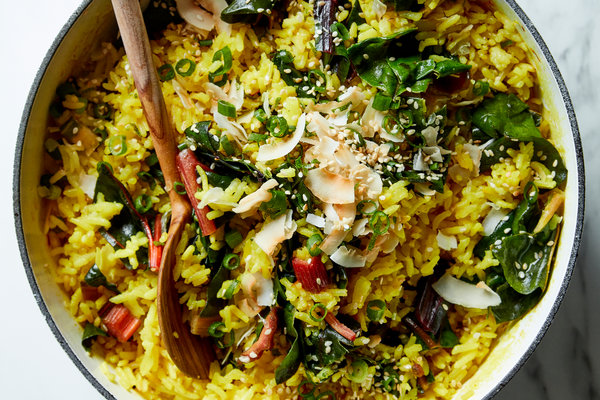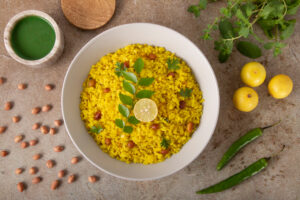
I am spending this week eating simple home-cooked meals after the over-indulgence and richer foods of the holidays. I came across this turmeric rice recipe from the NYT and made it today for lunch. It’s a delicious way to eat right for the season, and at the same time give yourself a simple warming, easy to digest meal.
No matter how you modify this one-pot rice, it can’t help but simultaneously comfort and enliven: The rice is cooked with turmeric, black pepper, and rich coconut milk, which is all brightened by a mix of coconut, sesame seeds, and lime. The greens, which conveniently cook on top of the rice, can be swapped out for anything that steams in 10 minutes, such as frozen peas or edamame, green beans, broccoli, grated carrots or sliced fennel. This dish has a relatively pure, mild flavor, so if you want more oomph, add more turmeric and saffron and season with plenty of salt and pepper as you cook. Check them out here.

Eastern View: The sesame seed, Sesamum indicum, is a tiny gem that packs a mighty punch. Each sesame seed is protected by an outer shell that naturally opens when the seed ripens (giving rise to the phrase “Open Sesame”.) Sesame seed contains a good bit of dietary fiber, supporting a healthy colon, and as Vata sits in the colon; anything that protects and nourishes colon health is good for a Vata. Sesame oil has been used to support numerous health systems in the body, including the nervous system, ( another seat of vata), bones and muscles, skin and hair, the digestive tract including the colon, and the male and female reproductive system.
The sesame seed is sweet, pungent, astringent, and bitter, and has a heating effect. Its greatest benefit is in balancing vata. The heating nature of sesame can also be good for Kapha. It grows in a dry climate, and in turn, is beneficial when the dry quality is in excess, in other words, it combats the dryness often seen in Vatas.
Turmeric with its strong yellow color signifies its use as a liver herb that is good at drying damp and moving stagnation in the blood. It is a pungent, bitter and astringent herb that has a heating effect. It reduces excess Vata and works specifically on the digestive, circulatory, respiratory, and female reproductive systems.
Turmeric helps to promote healthy intestines by reducing pathogenic bacteria and destroying digestive toxins (ama). It has recently been proven to have an affinity for the large intestine and to play a preventative role in bowel cancer. Other clinical trials have proven its efficiency in treating stomach acidity and ulcers. It’s bitter and pungent flavors act on the digestive fire to nourish the blood.
It has a stimulant effect on the liver and increases the flow of blood through the hepatic system and increases bile output. This helps dissolve and prevent gallstones. It is traditionally considered a blood purifier and is often used for beautifying the skin and clearing systemic toxemia: eczema, urticaria (itching), psoriasis, and acne.
It treats inflammation of the joints, alleviates pain and strengthens the joints and tendons. Useful for treating arthritis, especially that dry arthritis that can play up this time of year.
Western View: Sesame seeds are heart-healthy choices that supply unsaturated fats as well as certain nutrients. Sesame seeds are rich in vitamin E (potent antioxidant), iron, omega-6 fatty acids, vitamin B6, magnesium, calcium, zinc, copper, dietary fiber and flavonoids phenolic antioxidants.
The presence of vitamin E and zinc helps in augmenting the elasticity of the skin; repairs damaged skin cells and promote the production of collagen. As Vatas have a tendency to line and wrinkle early – the benefits of sesame oil are clear here. All these enriching nutrients make sesame seeds and sesame oil a powerful antioxidant with antibacterial, antifungal, anti-inflammatory, antiviral, immune-stimulant, restorative, anti-rheumatic, carminative, tonic, anti-diabetic, anti-atherogenic, cardiac, dermatologic, laxative, emollient, warming and antidepressant properties. Wow! Great for anyone who gets the ‘winter blues’ this time of year.
Sesame seeds can fight off free radicals. Free radicals cause damage to our DNA, cells and proteins. This kind of damage can lead to diseases like Alzheimer’s and Parkinson’s and cancer. Certain substances like alcohol, tobacco smoke, pesticides, air pollutants and the food we eat generate free radicals. It’s important we eat a diet rich in antioxidants, to fight free radical damage and reduce oxidative stress.
Recently, science has started to back up what the Indians have known for a long time… turmeric really does contain compounds with medicinal properties. Turmeric contains curcumin, a substance with powerful anti-inflammatory and antioxidant properties.
Inflammation is incredibly important. It helps the body fight foreign invaders and also has a role in repairing damage. Although acute (short-term) inflammation is beneficial, it can become a major problem when it is chronic (long-term) and inappropriately deployed against the body’s own tissues. It is now believed that chronic, low-level inflammation plays a major role in almost every chronic, Western disease. This includes heart disease, cancer, metabolic syndrome, Alzheimer’s and various degenerative conditions. It turns out that curcumin is strongly anti-inflammatory, it is so powerful that studies show it matches the effectiveness of some anti-inflammatory drugs.
Curcumin actually targets multiple steps in the inflammatory pathway, at the molecular level. Curcumin blocks NF-kB, a molecule that travels into the nuclei of cells and turns on genes related to inflammation. NF-kB is believed to play a major role in many chronic diseases. In several studies, its potency has compared favorably to anti-inflammatory pharmaceutical drugs… except without the side effects.
Oxidative damage is believed to be one of the mechanisms behind aging and many diseases. Curcumin happens to be a potent antioxidant that can neutralize free radicals due to its chemical structure.
Curcumin boosts levels of the brain hormone BDNF, which increases the growth of new neurons and fights various degenerative processes in the brain such as Alzheimer’s and depression.
Ingredients
Instructions
There’s no one size fits all for what you should eat. If you would like to talk with me about what is the right diet for you, sign up for a complimentary consultation. Just click on the link to my online calendar to find a good time that works for you.
In health,

The Holistic HIghway integrates traditional Western medical practices with Ayurveda medicine, creating a focus on prevention through nutrition, diet, and exercise; use of the latest genetic testing and other diagnostic techniques; and prescribed combinations of botanical medicines, supplements, therapeutic diets, detoxification programs, or stress-management techniques.

Integrative Health Expert | Ayurveda Practitioner | Author | Speaker
Kerry is a globally recognized leader in integrative medicine and the science of health known as Ayurveda. She is passionate about raising awareness of the need for a change in contemporary medicine that focuses on patient empowerment and a health-based (rather than disease-based) medical system.
Kerry is connected with The University of Pittsburgh Center for Integrative Medicine and remains a pioneer in the field of integrative medicine where she has developed a personalized system to manage chronic disorders by incorporating fundamental changes in diet, behavior, and stress while focusing on genetics.
This individualized program is so successful that many of her clients have achieved maximum healing and vitality after years of chronic problems!
More to Explore
Contact
Disclaimer
The sole purpose of all the website content is to educate and provide information about Integrative Health, Genetics and Ayurveda.This information is not intended for use in the diagnosis, treatment, cure. or prevention of any disease.
Stay Connected